Located 9 miles north of downtown Silver Spring, Briggs Chaney is one of the densest neighborhoods in Montgomery County, but walking can feel unpleasant or even dangerous. However, some new public and private improvements may change that.
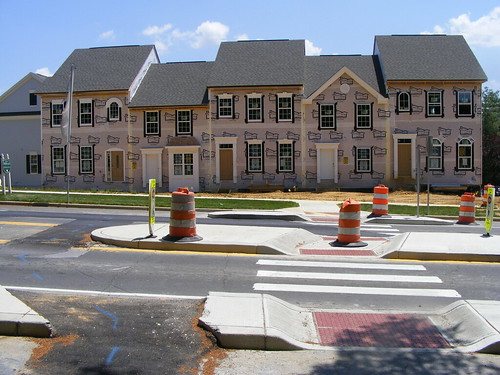
In the 1980's, Briggs Chaney was zoned for high-density residential development in anticipation of a light rail line that was never built. The neighborhood was built as planned, composed mainly of garden apartments and townhomes with a few single-family homes. Instead of light rail, it's served by a handful of infrequent bus routes including the Metrobus Z line, which happens to be one of the most well-used routes in suburban Maryland. However, 78% of Briggs Chaney's employed residents drive to work, while just 14% take transit and 2% walk.
This isn't surprising, since Briggs Chaney is far from the county's major employment centers, meaning driving may be the most practical way to commute for many residents. However, even though light rail may not ever be built here, the neighborhood will be served by Montgomery County's proposed Bus Rapid Transit system. And people who may use it in the future, along with current residents who don't drive, must deal with a neighborhood that was designed and built for cars.
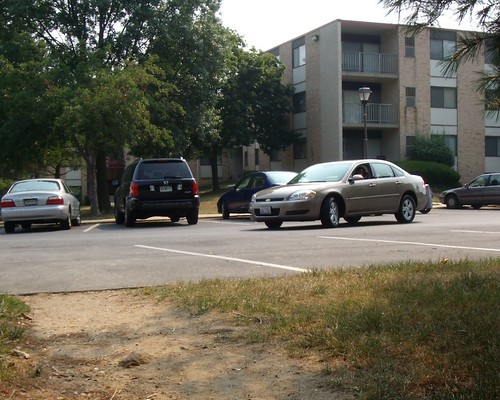
Briggs Chaney is chopped up into self-contained, fenced-off developments whose streets don't connect, making it really difficult to walk from one part of the neighborhood to another. The few connector streets that exist, like Robey Road, are wide and straight, making it easy to speed and putting pedestrians in danger.
There are also lots of awkward, unused public spaces behind apartment buildings or between complexes that invite loitering and crime, creating an atmosphere where residents don't feel safe. Though much of the neighborhood is within walking distance of Greencastle Elementary School, it doesn't participate in International Walk to School Day and students have to play inside.
How can we fix this? First, the streets must be redesigned to discourage speeding. Last fall, Montgomery County installed bumpouts, medians and crosswalks along Castle Boulevard, one of the neighborhood's main arteries. According to a study by the county Department of Transportation, 21 percent of drivers on this road drive over 40 miles per hour even though it's signed for 30.
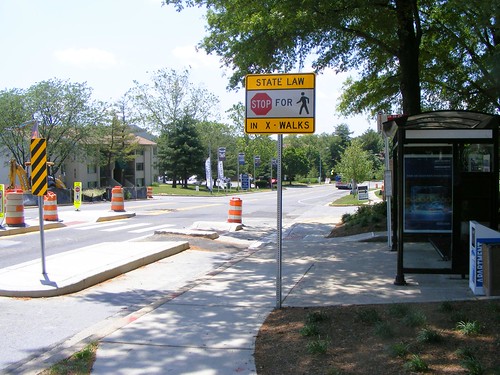
The bumpouts and medians will make the road narrower, slowing motorists and hopefully making them more aware of what's going on around them. They'll also give pedestrians a safe place to wait for a bus or to cross the street.
This may not change residents' perception of the street, however. For much of its length, Castle Boulevard is lined by fences, parking lots, and the backs of apartment buildings. These are the awkward, unused spaces that invite disinvestment and crime; in turn, they make the street susceptible to disinvestment and crime as well.
To change that, we have to orient buildings to the street. Castle Boulevard would be a livelier, and thus much safer, place if it was lined by front yards or other semi-public spaces. It's a lot easier to commit illegal activities if you're not directly in front of somebody's front door.
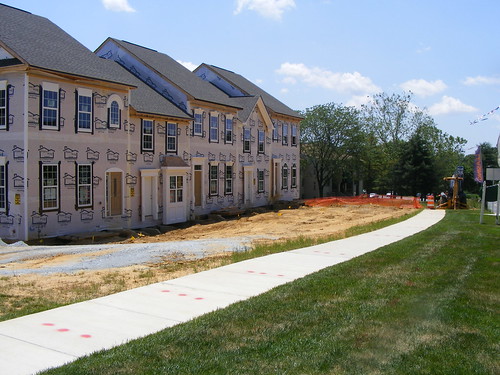
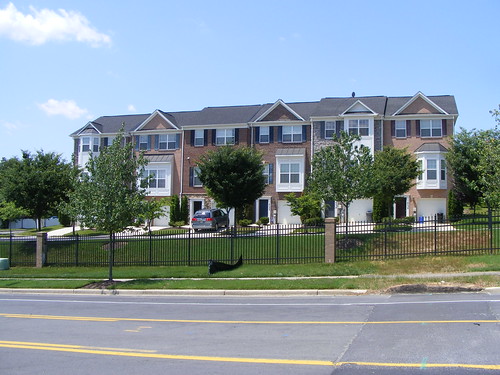 Left: new townhouses at Woodlake have front yards along Castle Boulevard. Right: townhouses across the street hide behind driveways and a tall fence.
Left: new townhouses at Woodlake have front yards along Castle Boulevard. Right: townhouses across the street hide behind driveways and a tall fence.
And that's exactly what local builder Craftstar Homes is doing at Woodlake, a new townhouse development being built around an existing garden apartment complex of the same name. This project provides more owner-occupied housing in a neighborhood where almost two-thirds of the households are renters, giving it more stability. It also treats Castle Boulevard with respect, placing front yards and shared courtyards along the street.
Unlike most townhouses being built in East County, these homes have rear garages on alleys. The front of these houses is actually the front, where you'll see people, not just cars. That creates "eyes on the street," further discouraging destructive behavior. It also means there's actually a front yard with grass or landscaping, which is generally more attractive than a line of driveways or a tall fence like those at another recently-built townhouse development across the street.
Of course, there aren't a lot of opportunities for new construction in Briggs Chaney, and it's unlikely that the neighborhood will get redeveloped any time soon. But many garden apartment buildings have entrances on both sides or patios facing the street, making it easy to for residents to "claim" those spaces as yards as well.
Together, these road improvements and new homes are a step forward for Briggs Chaney. Not only do they make it easier and safer to walk there, but they will help knit together many disparate parts into one coherent neighborhood.

In the 1980's, Briggs Chaney was zoned for high-density residential development in anticipation of a light rail line that was never built. The neighborhood was built as planned, composed mainly of garden apartments and townhomes with a few single-family homes. Instead of light rail, it's served by a handful of infrequent bus routes including the Metrobus Z line, which happens to be one of the most well-used routes in suburban Maryland. However, 78% of Briggs Chaney's employed residents drive to work, while just 14% take transit and 2% walk.
This isn't surprising, since Briggs Chaney is far from the county's major employment centers, meaning driving may be the most practical way to commute for many residents. However, even though light rail may not ever be built here, the neighborhood will be served by Montgomery County's proposed Bus Rapid Transit system. And people who may use it in the future, along with current residents who don't drive, must deal with a neighborhood that was designed and built for cars.

Briggs Chaney is chopped up into self-contained, fenced-off developments whose streets don't connect, making it really difficult to walk from one part of the neighborhood to another. The few connector streets that exist, like Robey Road, are wide and straight, making it easy to speed and putting pedestrians in danger.
There are also lots of awkward, unused public spaces behind apartment buildings or between complexes that invite loitering and crime, creating an atmosphere where residents don't feel safe. Though much of the neighborhood is within walking distance of Greencastle Elementary School, it doesn't participate in International Walk to School Day and students have to play inside.
How can we fix this? First, the streets must be redesigned to discourage speeding. Last fall, Montgomery County installed bumpouts, medians and crosswalks along Castle Boulevard, one of the neighborhood's main arteries. According to a study by the county Department of Transportation, 21 percent of drivers on this road drive over 40 miles per hour even though it's signed for 30.

The bumpouts and medians will make the road narrower, slowing motorists and hopefully making them more aware of what's going on around them. They'll also give pedestrians a safe place to wait for a bus or to cross the street.
This may not change residents' perception of the street, however. For much of its length, Castle Boulevard is lined by fences, parking lots, and the backs of apartment buildings. These are the awkward, unused spaces that invite disinvestment and crime; in turn, they make the street susceptible to disinvestment and crime as well.
To change that, we have to orient buildings to the street. Castle Boulevard would be a livelier, and thus much safer, place if it was lined by front yards or other semi-public spaces. It's a lot easier to commit illegal activities if you're not directly in front of somebody's front door.

 Left: new townhouses at Woodlake have front yards along Castle Boulevard. Right: townhouses across the street hide behind driveways and a tall fence.
Left: new townhouses at Woodlake have front yards along Castle Boulevard. Right: townhouses across the street hide behind driveways and a tall fence.And that's exactly what local builder Craftstar Homes is doing at Woodlake, a new townhouse development being built around an existing garden apartment complex of the same name. This project provides more owner-occupied housing in a neighborhood where almost two-thirds of the households are renters, giving it more stability. It also treats Castle Boulevard with respect, placing front yards and shared courtyards along the street.
Unlike most townhouses being built in East County, these homes have rear garages on alleys. The front of these houses is actually the front, where you'll see people, not just cars. That creates "eyes on the street," further discouraging destructive behavior. It also means there's actually a front yard with grass or landscaping, which is generally more attractive than a line of driveways or a tall fence like those at another recently-built townhouse development across the street.
Of course, there aren't a lot of opportunities for new construction in Briggs Chaney, and it's unlikely that the neighborhood will get redeveloped any time soon. But many garden apartment buildings have entrances on both sides or patios facing the street, making it easy to for residents to "claim" those spaces as yards as well.
Together, these road improvements and new homes are a step forward for Briggs Chaney. Not only do they make it easier and safer to walk there, but they will help knit together many disparate parts into one coherent neighborhood.

No comments:
Post a Comment